Binary Tree Traversals
Time Limit: 1000/1000 MS (Java/Others) Memory Limit: 32768/32768 K (Java/Others)Total Submission(s): 1406 Accepted Submission(s): 655
In a preorder traversal of the vertices of T, we visit the root r followed by visiting the vertices of T1 in preorder, then the vertices of T2 in preorder.
In an inorder traversal of the vertices of T, we visit the vertices of T1 in inorder, then the root r, followed by the vertices of T2 in inorder.
In a postorder traversal of the vertices of T, we visit the vertices of T1 in postorder, then the vertices of T2 in postorder and finally we visit r.
Now you are given the preorder sequence and inorder sequence of a certain binary tree. Try to find out its postorder sequence.

9 1 2 4 7 3 5 8 9 6 4 7 2 1 8 5 9 3 6
7 4 2 8 9 5 6 3 1
#include <iostream>
#include <algorithm>
using namespace std;
int preorder[1005];
int inorder[1005];
void dfs(int pre,int in,int size,bool flag)
{
int i;
if(size==1) //如果有左子树或右子树,就直接输出
{
printf("%d ",preorder[pre]);
return ;
}
if(size<=0) //没有左子树或右子树,则返回上层,遍历右子树或者根
return ;
for(i=0;preorder[pre]!=inorder[in+i];i++);//查找根节点在中序中的位置
dfs(pre+1,in,i,false); //左子树的遍历
dfs(pre+i+1,in+i+1,size-i-1,false); //右子树的遍历
if(flag) //输出根节点
printf("%d\n",preorder[pre]); //整个树的根节点
else
printf("%d ",preorder[pre]); //一般的根节点
}
int main()
{
int n,i;
while(cin>>n)
{
for(i=1;i<=n;i++)
scanf("%d",&preorder[i]);
for(i=1;i<=n;i++)
scanf("%d",&inorder[i]);
dfs(1,1,n,true);
}
return 0;
}








 本文介绍如何通过已知的二叉树的前序序列和中序序列,来推导出该二叉树的后序序列,涉及到的数据结构与算法知识。
本文介绍如何通过已知的二叉树的前序序列和中序序列,来推导出该二叉树的后序序列,涉及到的数据结构与算法知识。
















 298
298

 被折叠的 条评论
为什么被折叠?
被折叠的 条评论
为什么被折叠?








